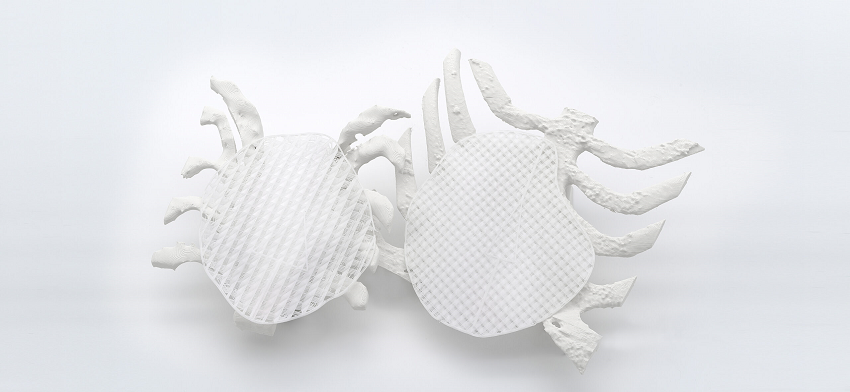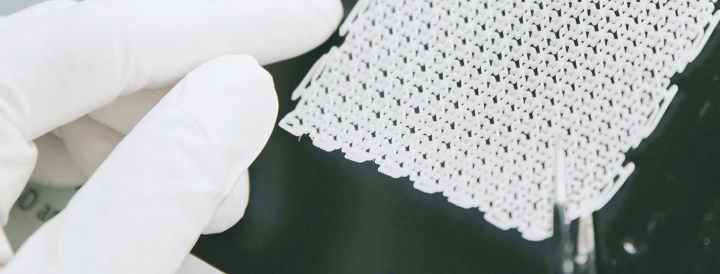Medtech company BellaSeno GmbH, headquartered in Leipzig, Germany, with its BellaSeno Pty subsidiary in Brisbane, Australia, specializes in the development of resorbable soft tissue and bone reconstruction implants, made with ISO 13485-certified, AI-driven 3D printing. The company was founded in 2015, and recently announced that it is beginning two clinical trials of its 3D printed implant products in Australia. The clinical trials will be for its Senella chest implants, used to treat pectus excavatum, and Senella breast implants.
Senella 3D Printed Implants
Senella is the company’s patented porous scaffold used for the 3D printed implants. Made of resorbable polycaprolactone (PCL), it has specialized topological and design features that are essentially recipients for injected fat tissue. Senella implants were designed to be absorbed by the patient over a period of five years, and offer a stable place for the fat tissue to mature and adapt. This results in a natural soft tissue with no foreign material—meaning it could lessen the complications so often seen in current breast augmentation and reconstruction approaches.
“It is important to us that patients have access to healthier alternatives to permanent implants,” explained Professor Owen Ung, Director of the Comprehensive Breast Cancer Institute (CBCI) and a consultant breast surgeon at the Royal Brisbane and Women’s Hospital, and Professor of Surgery, University of Queensland. “There is a strong demand for restoring fully natural breast tissue without potentially risky remnants in the body. We believe that BellaSeno´s solutions can play an important role in addressing these needs.”
Clinical Trials Begin
Recruiting for the two clinical trials has already begun in Brisbane, and the first trial will enroll ten patients with pectus excavatum, which is a common congenital deformity of the chest wall where the breastbone is sunken into the chest. Dr. Michael Wagels, Director of the Herston Biofabrication Institute (HBI), Specialist Plastic and Reconstructive Surgeon at the Princess Alexandra Hospital, Director of the Australian Centre for Complex Integrated Surgical Solutions (ACCISS), and Senior Lecturer at the University of Queensland, is the principal investigator of this trial.
“We are delighted to spearhead the administration of novel, fully absorbable implants for soft tissue reconstruction applications,” Dr. Wagels said. “There is a clear need for a safe alternative to contemporary alloplastic materials and operative techniques in pectus excavatum and breast surgery. Having customizable implants that resorb, leaving behind the patient’s own tissues, is a big step forward.”
BellaSeno actually published first-in-human data in 2021 for its 3D printed Senella Pectus implants, which showed that they were able to camouflage one of these defects that could not be reconstructed using conventional methods. So this clinical trial is definitely starting off on the right foot.
Professor Ung is the principal investigator for the second trial, which hopes to enroll twenty patients who need either breast implant revision, or surgery to fix congenital breast defects. Patients in each of the two clinical trials will receive 3D printed porous PCL implants, which were produced using a no-touch approach in BellaSeno’s AM facilities.
“This trial is a very important step for us to demonstrate that our approach is not only safe, but leads to substantial improvements in terms of long-term safety, health and quality of life. We very much hope the trials once more confirm our scaffold-guided tissue reconstruction concept,” said BellaSeno’s CMO Dr. med. Tobias Grossner.
The Advantages of Resorbable Implants
PCL has been used in healthcare applications for many years as an absorbable suture material, and its biodegradability, strength, and low melting point make it a good material for 3D printed scaffolds. During a minimally invasive surgery, BellaSeno’s 3D printed PCL implants are inserted in a compressed form; later, the structure unfolds, and eventually begins to graft with the patient’s own fat tissue, which the surgeon gets through a liposuction procedure. As previously mentioned, the scaffold is fully absorbed into the patient’s body, and replaced by fat cells, within five years—leaving no remnants of foreign materials behind. The company designed its novel implants to result in totally natural tissue, and the scaffold-guided tissue reconstruction (SGTR) procedure seems like a good alternative to other permanent implants, such as silicone.
The primary outcome of BellaSeno’s clinical trials will be both intra- and post-operative device safety. The secondary endpoints will be frequency of complication and adverse event rate, including change in fat volume, qualify of life, pain levels, and soft tissue retention.
(Images courtesy of BellaSeno)
Subscribe to Our Email Newsletter
Stay up-to-date on all the latest news from the 3D printing industry and receive information and offers from third party vendors.
You May Also Like
Gorilla Sports GE’s First 3D Printed Titanium Cast
How do you help a gorilla with a broken arm? Sounds like the start of a bad joke a zookeeper might tell, but it’s an actual dilemma recently faced by...
Nylon 3D Printed Parts Made More Functional with Coatings & Colors
Parts 3D printed from polyamide (PA, Nylon) 12 using powder bed fusion (PBF) are a mainstay in the additive manufacturing (AM) industry. While post-finishing processes have improved the porosity of...
$25M to Back Sintavia’s Largest Expansion of Metal 3D Printing Capacity Since 2019
Sintavia, the digital manufacturing company specializing in mission-critical parts for strategic sectors, announced a $25 million investment to increase its production capacity, the largest expansion to its operations since 2019....
Velo3D Initiates Public Offering in a Bid to Strengthen Financial Foundations and Drive Future Growth
Velo3D (NYSE: VLD) has been among a number of publicly traded 3D printing firms that have attempted to weather the current macroeconomic climate. After posting a challenging financial report for 2023,...


































